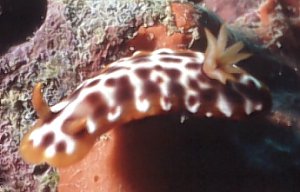

Hypselodoris purpureomaculosa
Hamatani, 1995
Order: NUDIBRANCHIA
Suborder: DORIDINA
Family: Chromodorididae
DISTRIBUTION
Known from Japan, Okinawa and the Philippines.
PHOTO
UPPER: Bohol Beach Club, Panglao, Philippines, 9 m, Oct. 29, 1998. Photo: Erwin Koehler
LOWER: Batangas Channel, Puerto Galera, Oriental Mindoro Province, the Philippines, 13.1 m, 10 December, 2001. Approx 42mm. Photo: Todd Garthwaite.
Reference:
• Hamatani, I. (1995) Two species of Chromodorididae (Nudibranchia), one newly recorded and one newly established, from Middle Japan. Venus, The Japanese Journal of Malacology, 54(2): 101-107.
Rudman, W.B., 1998 (December 15) Hypselodoris purpureomaculosa Hamatani, 1995. [In] Sea Slug Forum. Australian Museum, Sydney. Available from http://www.seaslugforum.net/find/hypspurp
Related messages
Hypselodoris purpureomaculosa from Lembeh
March 30, 2010
From: De Lorenzi Franco

Dear Dr Rudman
This summer in Lembeh I found this doridae. I tried to identify it but in all my books there is nothing similar, therefore I thought it is a juvanile form or what else. I hope it may be an interesting species.
Locality: Nudi falls - Lembeh strait, 25 m, indonesia, indopacific ocean, 24 august 2009, broken coral, sand. Length: 15 mm. Photographer: De Lorenzi Franco.
Thanks for your help.
Franco
cratena@tiscali.it
De Lorenzi Franco, 2010 (Mar 30) Hypselodoris purpureomaculosa from Lembeh . [Message in] Sea Slug Forum. Australian Museum, Sydney. Available from http://www.seaslugforum.net/find/23354Dear Franco,
This is Hypselodoris purpureomaculosa which seems to be quite common in the Indonesian region
Best wishes,
Bill Rudman
Hypselodoris purpureomaculosa from the Philippines
July 21, 2008
From: Marcel Tanke


Concerning message #20367:
Dear Bill,
Please find attched a few pictures from some more Hypselodoris purpureomaculosa, also from Anilao. I noticed there or 2 colour pattern variations. One with distinct, separate (sometimes touching each other) black spots. And one [lower photo] with more diffuse black spots. Normal variations within the species?
Locality: Anilao, 10-15 meters, Philippines , 6 to 13 July 2008. Length: 8 cm. Photographer: Marcel Tanke.
Best regards,
Marcel
marceltanke@cs.com
Tanke, M.A., 2008 (Jul 21) Hypselodoris purpureomaculosa from the Philippines. [Message in] Sea Slug Forum. Australian Museum, Sydney. Available from http://www.seaslugforum.net/find/21720
Dear Marcel,
I think we can say this is normal variability in the species. It usually takes a few years after a species is described before we can be sure we have a good idea about its variability. In some cases we find that what looked like a perfectly 'good' species when it was first named turns out to be just a colour variation when we learn more about it. Posting variations on the Forum like this is a very useful way to accumulate more information on these species.
Best wishes,
Bill Rudman
Feeding Hypselodoris purpureomaculosa from Philippines
August 1, 2007
From: Mike Krampf


Here is a picture of a Hypselodoris purpureomaculosa feeding that was taken in Anilao. I assume the skeleton of the sponge is the result of the feeding nudibranch.
Locality: Anilao area, 45 ft, Batangas, Philippines, South China Sea, 28 April 2007, Fringing reef. Length: 4 cm. Photographer: Mike Krampf.
Cheers,
Mike
mtkrampf@yahoo.com
Krampf, M., 2007 (Aug 1) Feeding Hypselodoris purpureomaculosa from Philippines. [Message in] Sea Slug Forum. Australian Museum, Sydney. Available from http://www.seaslugforum.net/find/20367
Dear Mike,
Thanks for this. Yes the network of sponge fibres is almost certainly the result of the Hypselodoris. From the shape of the sponge skeleton and the colour of the sponge I am pretty sure this is the species of Euryspongia which we have found this species on before [see #19243]. Hopefully, with the help of contributors like you, we can now start to build up multiple feeding records of many species, which is just as important as new feeding records, as it helps work out just how specific each species is to its food sponges. While some may feed on a group of sponges in one genus, or one family, others seem to specialise on a single species. It looks as though Hypselodoris purpureomaculosa may specialise on the sponge genus Euryspongia.
Best wishes,
Bill Rudman
Hypselodoris purpureomaculosa from Indonesia
May 10, 2007
From: Mickey Rosenau

I've unsuccessfully search four books and a few hundred images on Sea Slug Forum. Can someone help with identification?
Locality: Waigeo Island, Raja Ampat, 20-40 feet (?), Indonesia, 03 January 2007, Somewhere near the pearl farm. Length: 30 mm (?). Photographer: Mickey Rosenau.
Mickey Rosenau
mrosenau@houston.rr.com


Dear Mickey,
This is Hypselodoris purpureomaculosa. You will see from other messages on the Forum that the purple spots, which give this species its name, range in colour from red to almost black in different animals. One interesting observation you have recorded in your photo is the pinkish food sponge of this species. It is a dysideid of the genus Euryspongia. We have one earlier record of this species feeding on this sponge so another is a valuable confirmation [message #19243 ]
Best wishes,
Bill Rudman
Hypselodoris purpureomaculosa from Nth Borneo [2]
January 18, 2007
From: Richard Swann

Re: message #19243
Hi again Bill
I just dug out a couple of shots I took on 6 July 2006 at approx 12 m. I was in the same park but off Mamutik island (less than half a kilometer from the last pics I sent ).
Thanks again for your time, hope you find it of interest
Regards
Richard
richard@downbelow.co.uk
Swann, R., 2007 (Jan 18) Hypselodoris purpureomaculosa from Nth Borneo [2]. [Message in] Sea Slug Forum. Australian Museum, Sydney. Available from http://www.seaslugforum.net/find/19245
Dear Richard
Thanks for another record of Hypselodoris purpureomaculosa. Although this doesn't show the animal 'doing anything' like your earlier photo, it shows the distribution of the mantle glands around the edge of the mantle. If you look carefully you can see opaque whitish spots under the orange band. In their comprehensive review of Hypselodoris in the Indo-West Pacific, Gosliner & Johnson (1999) suggested that there were quite marked differences in the distribution of these mantle glands in different species. In this species they described a pattern of small glands, all of similar size, closely packed and distributed evenly all around the mantle edge. Your photo seems to reflect that description very well.
- Gosliner, T.M. & Johnson, R.F. (1999) Phylogeny of Hypselodoris (Nudibranchia: Chromodorididae) with a review of the monophyletic clade of Indo-Pacific species, including descriptions of twelve new species. Zoological Journal of the Linnean Society, 125: 1-114.
Best wishes,
Bill Rudman
Hypselodoris purpureomaculosa - from North Borneo
January 18, 2007
From: Richard Swann

Hello
I wondered if you could help me id these two. I took the shot at 21 m in the Tunku Abdul Rahman Park Kota Kinabalu, North Borneo. The area is generally quite sheltered with the reefs reaching a max depth of around 24 m. I have seen many here at various depths between 9 and 22 m but can't find them in my books. They resemble Chromodoris fidelis but has markings on the foot and also orange gills and rhinophores, as you can see they are tucking into the coral which I often observe them eating.
Locality: Sulug island, Tunku Abdul Rahman Park, Kota Kinabalu, 21 meters, Sabah, Borneo, South China Sea, 7th January 2007, gentle sloping reef sandy bed after 24m. Length: largest one 2cm. Photographer: Richard Swann.
Many thanks for your time
Richard
richard@downbelow.co.uk


Dear Richard,
This is a very interesting find. It is the chromodorid, Hypselodoris purpureomaculosa, a species we know very little about. Of particular interest is that these animals are clearly feeding, not on coral, but a dysideid sponge, Euryspongia. The white network visible in the lower left enlargement photo is part of the sponge colony the slugs have already eaten - all that is left are the spongin fibres which form the sponge skeleton. This is the first record we have of this species feeding.
Any other photos you have of nudibranchs feeding would be welcome. There are many more scuba divers with cameras out there than there are sea slug researchers. I like to think that one of the values of the Forum is that it provides a way for amateur observations to be more than private memories - they can become valuable bits of information which will help us better understand these fascinating animals.
Best wishes,
Bill Rudman
Hypselodoris purpureomaculosa from Indonesia
July 13, 2003
From: Roberto Sozzani

Dear Bill,
I'm back again with more questions...
This time I've this animal I can't identify:
Location: Rinja Is. (Indonesia)
Depth: 18m.
Size: 3cm.
Date: Feb. 2003
Thanks!
Best wishes.
Roberto
roberto.sozzani@fastwebnet.it
Sozzani, R., 2003 (Jul 13) Hypselodoris purpureomaculosa from Indonesia. [Message in] Sea Slug Forum. Australian Museum, Sydney. Available from http://www.seaslugforum.net/find/9953Dear Roberto,
This is Hypselodoris purpureomaculosa.
Best wishes,
Bill Rudman
Hypselodoris purpureomaculosa from Solomon Ids (2)
January 29, 2003
From: Bruce Potter

Dear Bill,
I found a juvenile Hypselodoris purpureomaculosa a few weeks ago, and have been looking for an adult ever since. Yesterday I found one. Of course it could be the same juvenile now grown into an adult, (I don't know how long that would normally take). However even if it is the same individual, it still suggests that there is at least one breeding pair here somewhere. Unfortunately it was not feeding, but just wandering along some dead coral, so I was not able to identify its food.
This was at about 12 meters on a coral and rubble site, on the outskirts of Honiara, Solomon Islands. It was about 45mm long.
Regards
Bruce Potter
bruce.potter@adventist.org.sb
Potter, B., 2003 (Jan 29) Hypselodoris purpureomaculosa from Solomon Ids (2). [Message in] Sea Slug Forum. Australian Museum, Sydney. Available from http://www.seaslugforum.net/find/9003Thanks Bruce,
Bill Rudman
Hypselodoris purpureomaculosa from the Solomons
January 2, 2003
From: Bruce Potter

Dear Bill,
I found this tiny juvenile this morning. It was only about 12mm long. I think it is a small Hypselodoris purpureomaculosa. I have only ever seen one of these here before, several years ago.
It was at about 18m on a coral and rubble site on the outskirts of Honiara, Solomon Islands [23 December 2002].
I shall keep an eye out, and hope to see it grow into an adult.
Regards
Bruce Potter
bruce.potter@adventist.org.sb
Potter, B., 2003 (Jan 2) Hypselodoris purpureomaculosa from the Solomons. [Message in] Sea Slug Forum. Australian Museum, Sydney. Available from http://www.seaslugforum.net/find/8742Thanks Bruce,
If you are lucky enough to find it more than once, guess I don't have to say that a photo of it eating something would be a bonus. This find, combined with your earlier report of this species from the Solomons, would suggest there is a resident population in the area
Best wishes,
Bill Rudman
Is this Hypselodoris purpureomaculosa?
August 1, 2002
From: Shouichi Kato


Dear Bill,
This animal, 40mm in size, were found by my staff member, Shigeru Harazaki, at rocky reef 15m in depth, here at Hachijo Island, Japan. Shigeru said it looks Hypselodoris purpureomaculosa but I'm not sure.
Please advise what do you think.
Best regards,
S. Kato
regulus@edit.ne.jp
Kato, S., 2002 (Aug 1) Is this Hypselodoris purpureomaculosa?. [Message in] Sea Slug Forum. Australian Museum, Sydney. Available from http://www.seaslugforum.net/find/7670Dear Shouichi,
Although the spots are more red than purple I am pretty sure this is a form of Hypselodoris purpureomaculosa. I have included a close-up of the anterior end because you can see the mantle glands around the mantle border. Gosliner & Johnson (1999) report that in this species the mantle glands are found all around the mantle edge with small elongate ones alternating with even smaller round ones with no apparent change in size. This is most unusual as in most species of Hypselodoris, the posterior mantle glands are usually quite a but larger than any mantle glands found elsewhere around the edge.
Best wishes,
Bill Rudman
Hypselodoris purpureomaculosa from the Philippines
March 8, 2002
From: Todd Garthwaite

Dear Bill,
Here are several pictures of a nudibranch which Terry Gosliner and David Behrens have kindly identified as Hypselodoris purpureomaculosa, from Puerto Galera in the Philippines. As it was first spotted by a dive-instructor (from Action Divers at Small LaLaguna Beach), named Simon, and because of it's tiger-like stripes we've taken to nicknaming it in layman's terms "Simon's Tiger." My friend Simon, who's been diving (& 'branching') in Puerto Galera for over 10 years, told me this is the first time he's ever seen this particular species of nudibranch. It was a first for me as well.
Here are some further details:
Data: Dec. 10, 2001, 12:49pm
Location: Batangas Channel, Puerto Galera, Oriental Mindoro Province, the Philippines
Depth: 13.1 meters
Water temperature: 24 deg. C.
Approximate size: 42+ mm
Incidentally, 'Batangas Channel' (as this not-so-popular dive site is known) has incredibly strong currents for a shallow area, and thus a wealth of diverse sponges. All of the most exotic and/or rare nudibranchs that I've come across in the Puerto Galera area have been there.
*By the way, here is a little information about myself, which seems to be the Forum's tradition for people posting for the first time. I'm from New Jersey, (USA), and I am a senior instructor of English as a Second Language (ESL), as well as a teacher trainer, here in Taipei, Taiwan. I've lived in Taiwan for nearly 11 years now, and I speak fluent Chinese. I've been an avid diver (& a "brancher") for 4 & half years. I've been pursuing U/W photography as a hobby for about a year & 1/2. I go diving (& "branching") off of Taiwan's Scenic N.E. Coast every week from mid-April to mid-October.
Take care & best wishes.
Todd Garthwaite
(Taipei, Taiwan)
typhoontoddy@yahoo.com


Thanks Todd,
Welcome to the Forum. Hypselodoris purpureomaculosa does not appear to be a very common species but it may be we haven't been looking the right places. If you have photos of nudibranchs from Taiwan they would be very welcome on the Forum as we know very little about the fauna of that part of the world.
best wishes,
Bill Rudman
Hypselodoris purpureomaculosa from Solomons
October 29, 2000
From: Bruce Potter

Bill,
I thought this find might be interesting to some. I notice that it is only supposed to be found in Japan and the Philipines, but here is one I found near Honiara, Solomon Islands.
Now I know it may be just a one off, rather than indicating a population, although I did find two of them a couple of weeks apart, and about 50 meters apart, so it could conceivably be the same one moving around.
Bruce.
bruce.potter@adventist.org.sb
Potter, B., 2000 (Oct 29) Hypselodoris purpureomaculosa from Solomons. [Message in] Sea Slug Forum. Australian Museum, Sydney. Available from http://www.seaslugforum.net/find/3243Dear Bruce,
Yes this is indeed an interesting find. Our existing knowledge of an animal's distribution is only as good as the information at present available to us. One of the aims of the Forum is to encourage interested divers and amateurs to let us all know of the things they find. Your photo is a good example of how you don't need to be a professional slug scientist to increase our knowledge of these animals.
Best wishes,
Bill Rudman.
Unidentified chromodorid from the Philippines
December 15, 1998
From: Erwin Koehler

Dear Bill,
can you turn my NO IDEA into ID? The shot was made at Bohol Beach Club, Panglao,
Philippines, depth 9 m, date Oct. 29, 1998.
Erwin Koehler
E.Koehler@deutschepost.de
Koehler, E., 1998 (Dec 15) Unidentified chromodorid from the Philippines. [Message in] Sea Slug Forum. Australian Museum, Sydney. Available from http://www.seaslugforum.net/find/390Sorry Erwin,
It looks like a chromodorid, possibly a Glossodoris, but I don't recognise it. If it's been recently described no doubt someone will let us know. ... Bill Rudman.
Philippine chromodorid
December 15, 1998
From: Terry Gosliner
Dear Bill,
Erwin's Philippine chromodorid is Hypselodoris purpureomaculosa Hamatani, 1995. Orignally described from Japan, it has also been found by Bob Bolland from Okinawa and from the Phillipines.
Terry
tgosliner@casnotes1.calacademy.org
Gosliner, T., 1998 (Dec 15) Philippine chromodorid. [Message in] Sea Slug Forum. Australian Museum, Sydney. Available from http://www.seaslugforum.net/find/392Thanks Terry,
I put Erwin's photo on the site at home this morning, caught the train to the museum, to find your message from California. Either Sydney's trains are very slow or the Sea Slug Forum is the place for fast results!
Bill Rudman.
